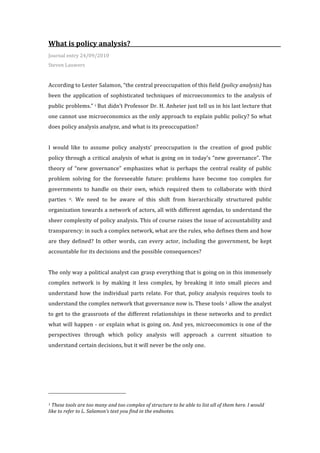Signaler
Partager
Télécharger pour lire hors ligne

Recommandé
Contenu connexe
Similaire à Journal 2: What is policy analysis?
Similaire à Journal 2: What is policy analysis? (20)
Donors, Development Agencies and the use of Political Economic Analysis: Gett...

Donors, Development Agencies and the use of Political Economic Analysis: Gett...
Ann Oper Res (2016) 2361–13DOI 10.1007s10479-015-1902-9.docx

Ann Oper Res (2016) 2361–13DOI 10.1007s10479-015-1902-9.docx
Jnl Publ. Pol., 32, 2, 79–98 r Cambridge University Press, 201.docx

Jnl Publ. Pol., 32, 2, 79–98 r Cambridge University Press, 201.docx
1. Public Policy Understanding public policy is both an art a.docx

1. Public Policy Understanding public policy is both an art a.docx
Public Policy Analysis (PPA)PresentationBYDr. Henry Akwo E.docx

Public Policy Analysis (PPA)PresentationBYDr. Henry Akwo E.docx
Dernier
Dernier (20)
Presentation by Andreas Schleicher Tackling the School Absenteeism Crisis 30 ...

Presentation by Andreas Schleicher Tackling the School Absenteeism Crisis 30 ...
Measures of Dispersion and Variability: Range, QD, AD and SD

Measures of Dispersion and Variability: Range, QD, AD and SD
Beyond the EU: DORA and NIS 2 Directive's Global Impact

Beyond the EU: DORA and NIS 2 Directive's Global Impact
ICT Role in 21st Century Education & its Challenges.pptx

ICT Role in 21st Century Education & its Challenges.pptx
Seal of Good Local Governance (SGLG) 2024Final.pptx

Seal of Good Local Governance (SGLG) 2024Final.pptx
SECOND SEMESTER TOPIC COVERAGE SY 2023-2024 Trends, Networks, and Critical Th...

SECOND SEMESTER TOPIC COVERAGE SY 2023-2024 Trends, Networks, and Critical Th...
Unit-V; Pricing (Pharma Marketing Management).pptx

Unit-V; Pricing (Pharma Marketing Management).pptx
Journal 2: What is policy analysis?
- 1. What is policy analysis? Journal entry 24/09/2010 Steven Lauwers According to Lester Salamon, “the central preoccupation of this field (policy analysis) has been the application of sophisticated techniques of microeconomics to the analysis of public problems.” i But didn’t Professor Dr. H. Anheier just tell us in his last lecture that one cannot use microeconomics as the only approach to explain public policy? So what does policy analysis analyze, and what is its preoccupation? I would like to assume policy analysts’ preoccupation is the creation of good public policy through a critical analysis of what is going on in today’s “new governance”. The theory of “new governance” emphasizes what is perhaps the central reality of public problem solving for the foreseeable future: problems have become too complex for governments to handle on their own, which required them to collaborate with third parties ii. We need to be aware of this shift from hierarchically structured public organization towards a network of actors, all with different agendas, to understand the sheer complexity of policy analysis. This of course raises the issue of accountability and transparency: in such a complex network, what are the rules, who defines them and how are they defined? In other words, can every actor, including the government, be kept accountable for its decisions and the possible consequences? The only way a political analyst can grasp everything that is going on in this immensely complex network is by making it less complex, by breaking it into small pieces and understand how the individual parts relate. For that, policy analysis requires tools to understand the complex network that governance now is. These tools 1 allow the analyst to get to the grassroots of the different relationships in these networks and to predict what will happen -‐ or explain what is going on. And yes, microeconomics is one of the perspectives through which policy analysis will approach a current situation to understand certain decisions, but it will never be the only one. 1 These tools are too many and too complex of structure to be able to list all of them here. I would like to refer to L. Salamon’s text you find in the endnotes.
- 2. The basis of governance, in whatever form we encounter it, should be evidence iii: evidence, acquired through thorough research that allows to critically analyze – and improve – the public policy currently in place. And that is where policy analysis comes in: whoever defines the problem has control of the design of solutions. iv By analyzing the outcomes of public policy, we can define the input that is required to improve public policy – and if it is necessary to do so. Professor Dr. M. Stürmer told us in his guest lecture that history is a dialogue between the living and the death, that history defines the future. And in assuming policy analysis helps to define public policy, our analysis of today’s governance will help to figure out how the future is best managed. We better get started. i Salamon, L. M. (2002): The New Governance and the Tools of Public Action: An Introduction, p. 7 ii Salamon, L. M. (2002): idem. iii Dunworth, T. et al (2003): Beyond Ideology, Politics, and Guesswork: The Case for Evidence-Based Policy. The Urban Institute, Revised Edition 2008. iv Moran M. et al (2006). The Oxford Handbook of Public Policy. Ingram H., Schneider A. L., Chapter 8: Policy Analysis for Democracy, p. 174. (Quote Bardach et al)